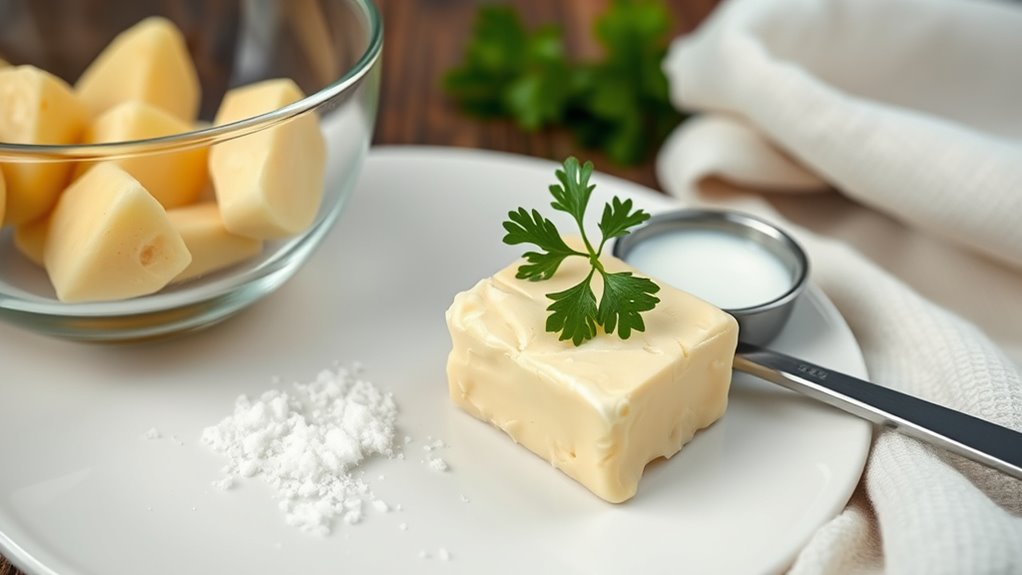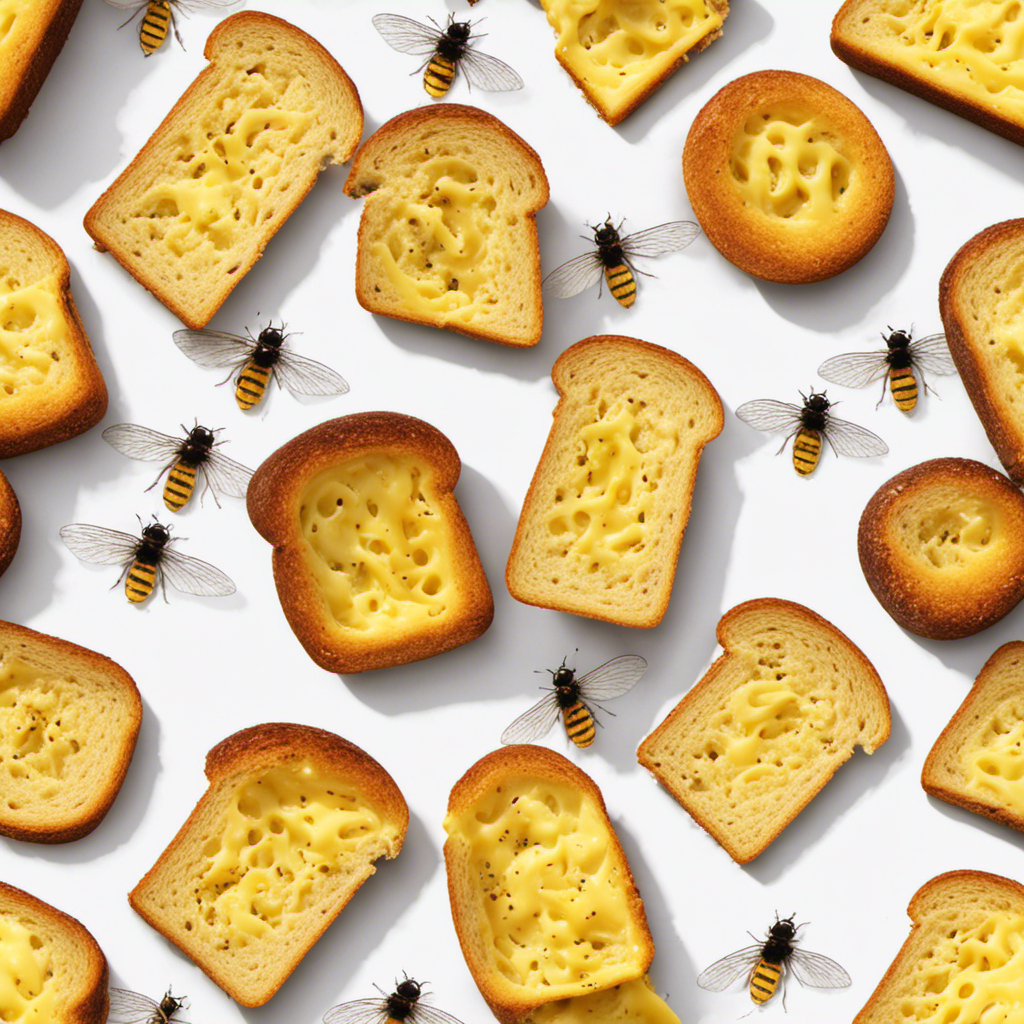To de-salt overly salty butter, rinse it gently under cold water to remove excess salt, then pat it dry. Mix it with unsalted butter or neutral fats to dilute the saltiness while improving texture. Adding a splash of lemon juice or vinegar can balance flavors with acidity. You can also stir in cornstarch or flour to absorb some salt. Finally, chilling in small portions helps you fine-tune the salt level—learn more tips to perfect your buttery creations.
Key Takeaways
- Rinse the butter in cold water using a fine mesh strainer or cheesecloth to wash away excess salt without softening it.
- Mix salty butter with unsalted butter or neutral fats like vegetable oil to dilute saltiness and improve texture.
- Add acidic ingredients such as lemon juice, vinegar, or yogurt gradually, tasting to balance the flavor.
- Incorporate small amounts of starches like cornstarch or flour to absorb excess salt evenly.
- Chill the butter thoroughly and adjust in small batches, adding unsalted butter or cream as needed to achieve desired salt levels.
Rinse and Redefine With Cold Water
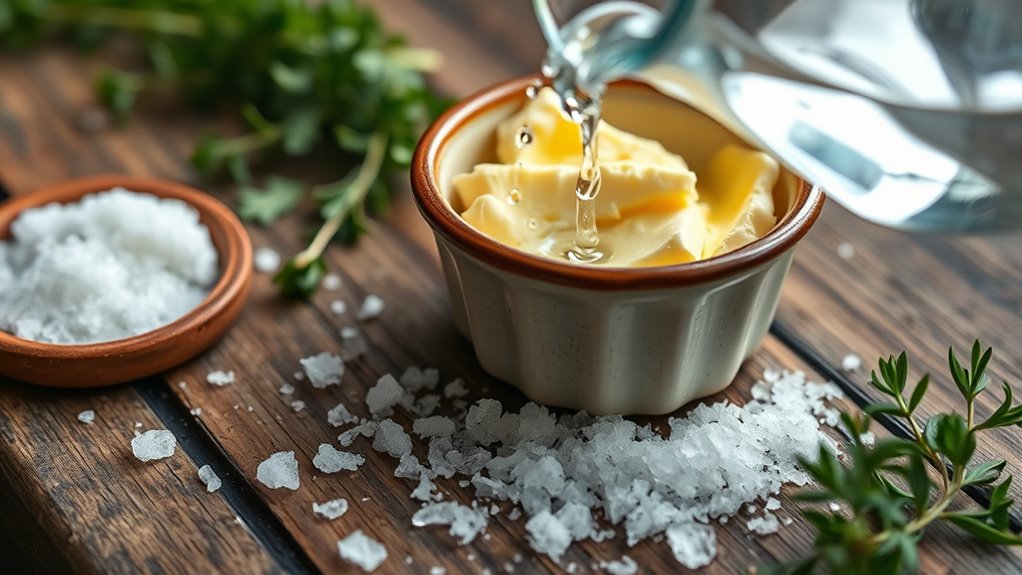
When your butter is too salty, rinsing it with cold water is a quick fix. This method helps reduce the salty taste without altering the butter’s texture too much. To do this, place the butter in a fine mesh strainer or cheesecloth and rinse gently under cold water. The water will wash away some of the excess salt, easing the salty flavor. Be careful not to soak the butter for too long, as it can become too soft or lose its consistency. Once rinsed, pat the butter dry with a paper towel. Rinsing preserves the butter’s smooth texture while diminishing the saltiness. Proper salinity levels are essential for achieving balanced flavor in butter. This simple step allows you to enjoy butter with a more balanced flavor, especially if the original salt level was overdone.
Mix With Unsalted Butter or Neutral Fat
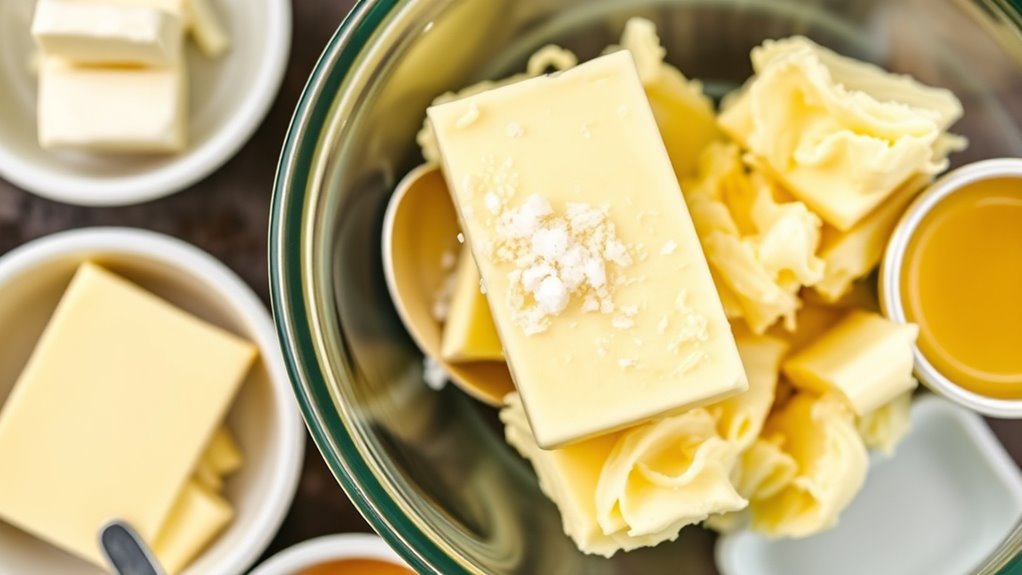
If your butter remains too salty after rinsing, mixing it with unsalted butter or a neutral fat is an effective way to balance the flavor. This method helps improve the butter’s texture, making it creamier and more spreadable, while also diluting the saltiness. By blending in unsalted butter or a neutral fat like vegetable oil, you can achieve a more desirable flavor profile without overwhelming your dish. It’s a simple, quick fix that preserves the butter’s natural qualities while reducing saltiness. Keep in mind, adding neutral fat won’t mask the salt entirely, but it will help mellow the overall flavor and enhance its smooth texture. This approach is especially useful when you want to maintain the butter’s versatility in cooking and baking. Additionally, choosing a neutral fat that is suitable for cooking ensures the flavor remains balanced and appropriate for your culinary needs.
Incorporate Acidic Ingredients to Balance Flavors
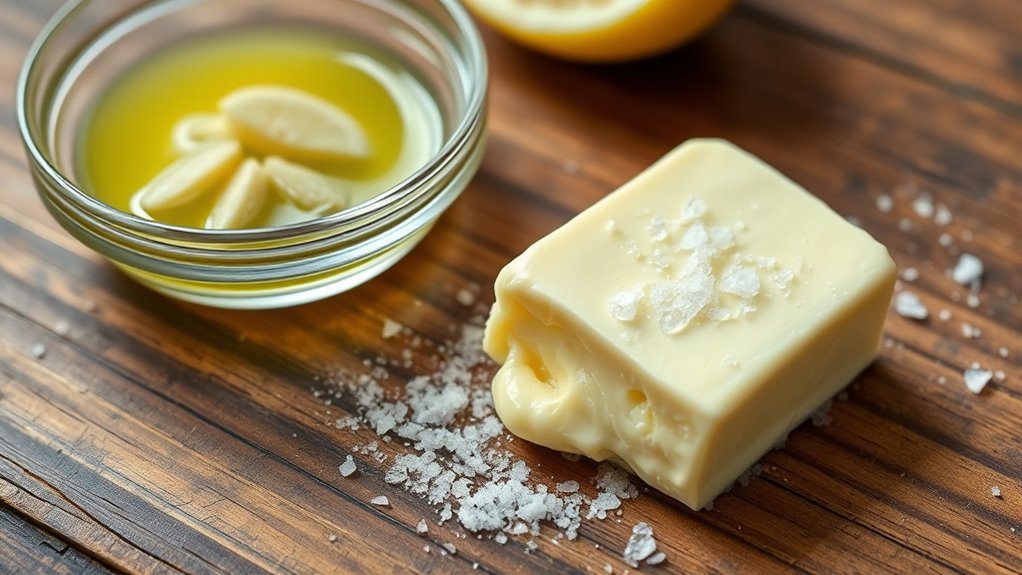
Adding acidic ingredients can effectively counteract the saltiness in overly salty butter. Acidic balance restores flavor harmony, making the butter taste more rounded and less overpowering. To achieve this, consider these options:
- Add a splash of lemon juice or vinegar—just a teaspoon at a time, tasting as you go.
- Mix in a small amount of yogurt or sour cream for creaminess and acidity.
- Incorporate a dash of tamarind or apple cider vinegar for a nuanced tang.
- Use a tiny bit of citrus zest to enhance brightness without overwhelming the butter.
- Being mindful of flavor balancing is essential, as ingredient proportions can influence the overall taste.
These acidic ingredients help cut through excessive salt, rebalancing flavors while preserving the butter’s richness. Keep in mind, the goal is subtlety—too much acid can overpower, disrupting flavor harmony.
Use Starch or Absorbing Agents
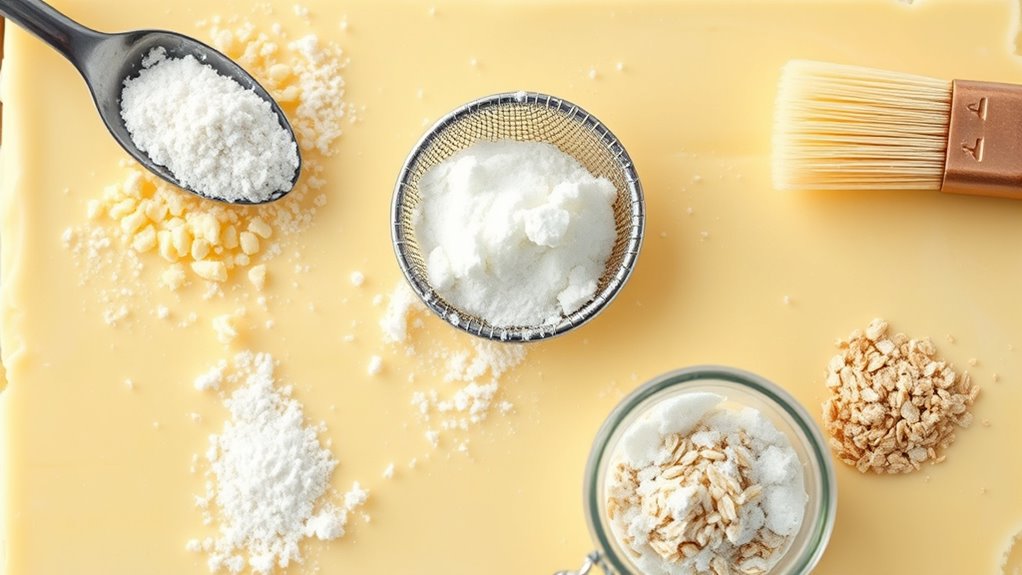
After balancing flavors with acidity, you can further reduce saltiness by incorporating starches or absorbing agents. Starch absorption works by drawing excess salt out of the butter, effectively binding the salt and preventing it from overpowering the dish. For example, mixing in a small amount of cornstarch or flour can help absorb some of the salt, making the butter less salty. Be careful not to add too much; start with a teaspoon, then gradually increase if needed. Stir thoroughly to ensure even distribution. This method is especially effective when the salt is unevenly distributed or excessive. Using starch or absorbing agents provides a simple, quick fix to salvage over-salted butter, restoring balance without altering flavor too much. Additionally, choosing sustainable ingredients can help reduce environmental impact during your cooking.
Chill and Adjust in Small Batches
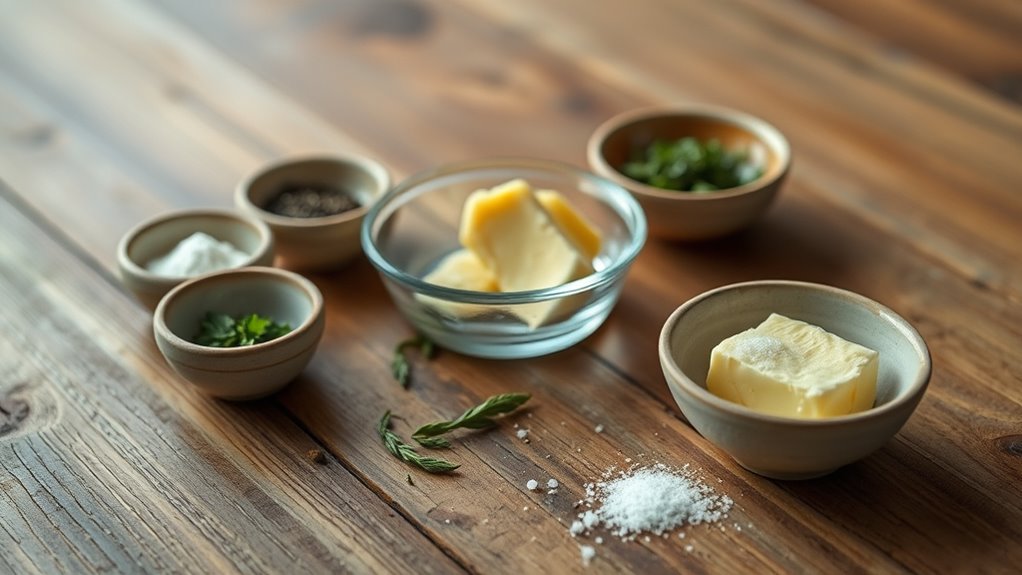
Chilling the butter and making adjustments in small batches allows you to control the saltiness more precisely. Temperature control helps prevent melting or over-softening, making flavor balancing easier. When you work with small portions, you can fine-tune the saltiness without risking waste. Here are some tips:
- Chill your butter thoroughly before adjustments to firm it up.
- Add small amounts of unsalted butter or cream to dilute excess salt.
- Taste frequently to avoid over-correcting.
- Use a thermometer to monitor temperature, ensuring consistent texture and flavor.
- Incorporating Cheesy Polenta or other mild dishes can help mellow out overly salty butter if needed.
Frequently Asked Questions
Can Saltiness in Butter Be Completely Eliminated?
You can’t completely eliminate saltiness in butter, but you can substantially reduce it while preserving flavor. To do so, you should focus on flavor preservation techniques like blending in unsalted butter or adding ingredients to mask the saltiness. Texture modification can also help, such as chilling or stirring to evenly distribute the salt, making the butter more balanced. While total removal isn’t possible, these methods improve taste and texture effectively.
How Long Does Each De-Salting Method Typically Take?
You wonder how long each de-salting method takes, and the answer varies. The duration comparison reveals some methods work quickly, within 10-15 minutes, while others may take up to an hour or more. The effectiveness timeline depends on the technique you choose; rinsing can be swift, but patience with repeated washes often yields better results. Keep in mind, achieving a perfectly balanced butter might require a bit of trial and time.
Will These Methods Affect the Butter’s Texture or Flavor?
You wonder if these de-salting methods will impact your butter’s texture or flavor. Generally, gentle techniques like rinsing or soaking cause minimal texture impact, but they might slightly alter flavor, making it less salty but still rich. Overdoing it could lead to a softer texture or subtle changes in flavor. So, you should carefully monitor each method to maintain the butter’s original quality while reducing salt.
Are There Specific Types of Butter Better Suited for These Techniques?
When choosing butter for de-salting techniques, focus on butter quality and salt distribution. High-quality butter with a consistent salt distribution responds better to these methods, ensuring less impact on flavor and texture. Unsalted or lightly salted butter is ideal, as you can better control salt levels. Avoid heavily salted or low-quality options, which might not de-salt evenly and could compromise the butter’s overall flavor and texture.
Can These Techniques Be Used for Other Salty Dairy Products?
Like finding a hidden gem, you can use these techniques with other salty dairy products. They work well for alternative dairy options like cream cheese or sour cream, helping you balance seasoning adjustments. Just remember, each product varies in salt content, so test and adjust gradually. These methods are versatile, giving you control over salt levels and ensuring your dishes taste just right without overpowering saltiness.
Conclusion
Now you’re armed with clever tricks to rescue overly salty butter, turning a kitchen mistake into a triumph. Remember, these methods can save your dish and even make you feel like a culinary genius—because no mistake is too big to conquer. With patience and a little ingenuity, you’ll master the art of perfect seasoning every time. Don’t let salty setbacks drown your confidence; instead, use them as stepping stones to culinary greatness!
